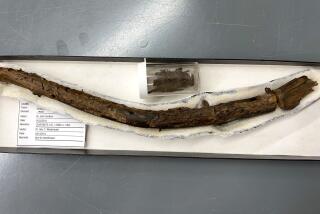Column One: Carnivorous plants losing ground in the U.S.
Reporting from Quincy, Calif. — — “This is the easy part,” says Barry Rice, half-sliding, half-falling down a ravine through a latticework of dead branches.
Decades ago, lush stands of Darlingtonia californica — emerald plants coiled like fanged cobras ready to pounce — grew at this spot in the northern reaches of the Sierra Nevada.
Deep in the ravine, the air is hot and dead. Pieces of bark that have sloughed off trees make every step a danger — nature’s equivalent of a thousand forgotten skateboards cluttering a driveway. Slate tinkles underfoot, and the ground feels like stale angel-food cake: stiff yet porous.
Rice, a botanist at UC Davis, is not the first to hunt the cobra lily here in Butterfly Valley. In 1875, amateur botanist Rebecca Austin fed the plants raw mutton and carefully observed how they digested it.
Yet to this day, much of the plants’ biology and habitat remain unknown — which is why Rice is here, trying to find established populations.
Near the bottom of the crevice, the ground becomes moist. The air cools and softens. This is where the cobra lilies would be. “When you see them, they look almost like animals,” Rice says.
But there are none to be seen.
Rice does find meat-eaters in some of the other places he checks out on this July weekend. But in three of seven places where they used to be, the plants have vanished. It’s a sad story that is playing out across the country in the valleys, bogs and bottoms where carnivorous plants once thrived.
The cobra lily, also known as the California pitcher plant, is comparatively lucky: Its stocks may be dwindling but its broad habitat affords something of a safety net.
Many of its brethren are faring far worse: insect-devouring butterworts, bladderworts, sundews, other pitcher plants and most famous of all, the Venus’ flytrap. The bulk of their U.S. habitat has disappeared, especially in the Southeast, mostly because of human encroachment of various kinds: development, poaching and suppression of naturally occurring wildfires.
Woodland fires remove taller foliage that keeps the stubby meat-eaters from getting enough sunlight. But because of development, allowing fires to burn in their habitats is often out of the question.
In California, alders have grown tall enough in some places to shade out the cobra lily.
In Georgia, botanists have hacked through thickening Appalachian forest in an effort to save the state’s last remaining colony of mountain purple pitcher plants.
In North Carolina, of about 250 Venus’ flytrap sites that existed in the 1930s, about two-thirds are left and just 32 have a good shot at survival, said Rob Evans, coordinator of the North Carolina Plant Conservation Program.
What plants remain are often plucked from swamps and bogs by poachers and hawked at roadside stands, farmers markets, nurseries or on the Internet.
“I remember visiting [one site] for the first time 30 years ago and there were probably 50 acres where you couldn’t take a step without there being a flytrap, and 30 years later, not a flytrap to be found,” said Johnny Randall, assistant director for conservation at the North Carolina Botanical Garden. “Literally hundreds of flytraps had been poached out of there.”
They possess a notable trait bequeathed by as much as 125 million years of evolution: the ability to capture and digest insects (and reputedly rats, in the case of Nepenthes rajah of Borneo, which can grow more than 3 feet high). Because they draw nutrients such as nitrogen from the carcasses of bugs instead of relying on their roots to extract minerals from the ground, they can live in the poor-quality soil found in bogs.
Most meat-eating plants passively trap their prey, relying on a bug’s clumsiness or carelessness. Sundews exude a sticky substance that traps insects; the many varieties of pitcher plant just wait for bugs to fall into their vases.
Some, like the cobra lily, have downward-pointing hairs to prevent insects from climbing out, and transparent patches on their leaves to trick bugs into heading for false exits.
The Venus’ flytrap is one of the few that actively traps its prey. When an unsuspecting fly, lured by scent, lands on a trigger vein in the leaf, the leaf snaps shut like a jaw, caging the victim with sawtooth-like spines.
Carl Linnaeus, known as the father of modern taxonomy, at first dismissed reports of the plant, convinced that such a thing could not exist. Charles Darwin, in his little-known work “Insectivorous Plants,” said that of all plants, the Venus’ flytrap was “one of the most wonderful in the world.”
Its native habitat is limited to a few parts of North and South Carolina, where by some estimates there are as few as 35,800 left. Many more survive “in captivity,” flytraps being one of the few carnivorous plants grown for a wider market.
Plants cultivated legally can be purchased in nurseries or the garden sections of hardware stores and supermarkets.
But taking carnivorous species from protected areas is illegal in many states. Law enforcement officials in the southeastern U.S. have learned to look for the telltale signs of poachers: A pickup truck parked on the side of the road bordering swampland is a giveaway.
Sgt. Jeremy Wall recalls heading into North Carolina’s Green Swamp one day in fall 2007 after getting a call from members of a hunting club. They’d spotted a Nissan pickup on the side of the road in the middle of the 16,000-acre swamp.
Wall suspected drugs at first: The swamp provides cover for anyone looking to grow marijuana. Then a man emerged from the woods with a backpack, and Wall knew what he was dealing with. The pack was stuffed not with pot, but with purple pitcher plants. The man and two companions had uprooted 500 of them, Wall said.
Still, they faced minimal punishment: The typical fine for a first offense in North Carolina is $100, plus a $125 court fee.
Sometimes poachers don’t pay at all. Lt. Matthew Long of the North Carolina Wildlife Resources Commission once encountered a truck sitting on a road in the Green Swamp, with no driver in sight. He and other officers followed the trail into the swamp, nearly stumbling over two women who had collected 295 flytraps.
“We stepped on them, laying flat down on their bellies, faces down, camouflage, kneepads,” Long said. “They were digging into [the plants] with butcher knives.”
Hey ladies, he recalled asking. What’s going on?
Oh, we were just taking a nap, they replied.
The women were arrested but were later released without having to pay fines, according to the local district attorney’s office.
If the risks of poaching are low, so are the returns. The plants sell for 25 cents each on the black market, said Ron Robertson, an enforcement officer with the North Carolina commission.
Nevertheless, poaching “is in an upswing,” Long said. “Because of the economy, people are more desperate.… Even people who are scared to death of snakes — that’s what they’re willing to do.”
Most law enforcement agencies don’t have the resources to pursue poachers aggressively. That’s why it’s rare to catch them in the act. Instead, federal and state officials and conservation groups focus on keeping secret the locations of remaining sites and on educating the public on the need to respect and preserve meat-eating plants.
In Oregon, officials have set up a site dedicated solely to the preservation of the cobra lily.
In North Carolina, the Nature Conservancy operates the Green Swamp, home to at least 14 different species of carnivorous plants, as a preserve. When poachers are nabbed, conservationists and government officials help replant the confiscated species in secret locations on protected property.
Sometimes, the best way to save native carnivorous plants is to kill nonnative ones, said Rice of UC Davis. Overenthusiastic amateur collectors have taken to transplanting meat-eating species in wild lands far from their native habitats. This can introduce disease and other invasive plants, Rice said.
He makes a merciless example of any interlopers he finds, hoping that enthusiasts will think twice about sticking plants where they don’t belong.
In California’s Butterfly Valley, Rice’s loud “Aha!” rings out in a forest glade. He has spotted a sundew from New Jersey, Drosera hybrida, hiding among its Californian cousins in an inch-deep layer of water.
He kneels and plucks it out of the soil. “Carnivorous plant growers will just die at what I’m about to do,” he says minutes later, having climbed out of the valley and onto the road.
With ceremony, he holds the uprooted alien high in the air, then drops it and grinds it to bits with his heel.
amina.khan@latimes.com







